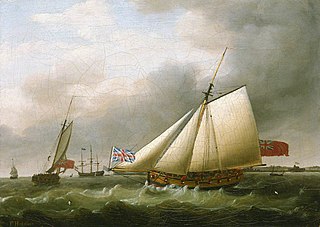
HMS Guadeloupe, was a 28-gun sixth-rate Coventry-class frigate of the Royal Navy. The ship was designed by Sir Thomas Slade, and was initially contracted to be built with the Pembrokeshire shipwright John Williams of Neyland; however he became bankrupt and the Admiralty transferred the order to the Plymouth Naval Dockyard.

HMS Lively was a 20-gun post ship of the Royal Navy, launched in 1756. During the Seven Years' War she captured several vessels, most notably the French corvette Valeur in 1760. She then served during the American Revolutionary War, where she helped initiate the Battle of Bunker Hill. The French captured her in 1778, but the British recaptured her in 1781. She was sold in 1784.
Sixteen ships of the Royal Navy have borne the name HMS Alert, while another was planned:
HMS Antigua has been the name of four ships of the Royal Navy, named after the Caribbean island of Antigua:
Fourteen ships and one shore establishment of the Royal Navy have borne the name HMS Merlin, after Merlin, the wizard in Arthurian legend :
HMS Ariel was a 20-gun Sphinx-class sixth-rate post ship of the Royal Navy. The French captured her in 1779, and she served during the American Revolutionary War for them, and later for the Americans, before reverting to French control. Her French crew scuttled Ariel in 1793 to prevent the British from recapturing her.

HMS Ambuscade was a 32-gun fifth-rate frigate of the Royal Navy, built in the Grove Street shipyard of Adams & Barnard at Depford in 1773. The French captured her in 1798 but the British recaptured her in 1803. She was broken up in 1810.

Glorieux was a 74-gun ship of the line in the French Navy. Built by Clairin Deslauriers at Rochefort and launched on 10 August 1756, she was rebuilt in 1777.
At least four ships of the Royal Navy have borne the name HMS Port Royal, after the British naval base Port Royal in Jamaica:

Iphigénie was a 32-gun Iphigénie-class frigate of the French Navy, and the lead ship of her class. She was briefly in British hands after the Anglo-Spanish capture of Toulon in August 1793 but the French recaptured her December. The Spanish captured her in 1795 and her subsequent fate is unknown.
Six ships of the Royal Navy have borne the name HMS Sandwich, either after the English seaside town of Sandwich, or one of the holders of the title Earl of Sandwich, particularly Vice-Admiral Edward Montagu, 1st Earl of Sandwich, or First Lord of the Admiralty John Montagu, 4th Earl of Sandwich. A seventh ship was planned, but never completed:

HMS Crescent was a 28-gun Enterprise-class sixth-rate frigate of the Royal Navy. Crescent was launched in 1779. The French captured her in 1781. She was wrecked in 1786.
HMS Port Royal was the former French armed merchant vessel Comte de Maurepas, which the British captured in 1778. The British armed her with 18 guns and took her into the Royal Navy under her new name. The Spanish captured her at the Siege of Pensacola in 1781.
HMS Shelanagig, was a sloop of 16-guns purchased in the West Indies in 1780 for the Royal Navy. She was under the command of James Shepherd,, and her Second Lieutenant was Home Popham.
HMS Sartine was a French merchant vessel from Bordeaux. The French Navy pressed her into service on 3 August 1778 to assist in the defense of Pondichéry. The British captured her during the Siege of Pondicherry (1778), and took her into service under her existing name. HMS Sartine foundered in action off Calicut in November 1780.

HMS Barbuda was commissioned into the Royal Navy in 1780 after having briefly served as an American privateer. Barbuda was one of the two sloops that captured Demerara and Essequibo in 1781, but the French Navy captured her there in 1782 and took her into service as Barboude. The French Navy sold her to private owners in 1786, and she served briefly as a privateer in early 1793 before the French Navy purchased her again and named her Légère. She served them until mid-1796 when the Royal Navy captured her and took her into service as HMS Legere. She was wrecked off the coast of Colombia, without loss of life, in February 1801.

HMS Ceres was an 18-gun sloop launched in 1777 for the British Royal Navy that the French captured in December 1778 off Saint Lucia. The French Navy took her into service as Cérès. The British recaptured her in 1782 and renamed her HMS Raven, only to have the French recapture her again early in 1783. The French returned her name to Cérès, and she then served in the French Navy until sold at Brest in 1791.
The French brig Duc de Chartres was built between 1779 and 1780 at Le Havre as a 24-gun privateer. As a privateer she captured one British warship before in 1781 the Royal Navy captured her. The Royal Navy took her into service as HMS Duc de Chartres. She then captured several American privateers and armed merchant vessels, and one French naval corvette in a noteworthy single-ship action. The Navy sold Duc de Chartres in 1784.
HMS Allegiance was the American vessel King George, which the British captured in 1779 and brought into the Royal Navy as a sloop armed with fourteen 6-pounder guns. The French captured her in 1782, and the British recaptured her in 1783, but did not take her back into service.

HMS Fly was a cutter that the Royal Navy purchased in 1778. The French Navy captured Fly in June 1781.








